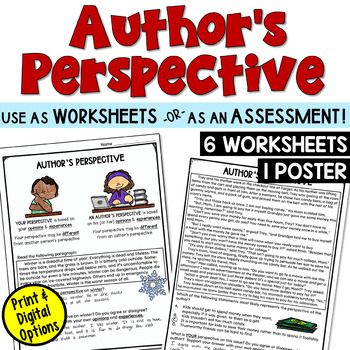Author's Perspective: 6 Worksheets with Practice Passages
- PDF
- Easel Activity
What educators are saying
Also included in
- This bundle has everything you need to keep your students engaged as they learn how to identify the author's point of view, or perspective. The activities in this bundle make learning about perspectives in reading fun and easy! Students love the activities while teachers love the convenience of thesPrice $11.50Original Price $20.50Save $9.00
Learning Objective
After reading a passage, students will identify the statement that most likely represents the perspective of the author. Students will write about their own perspective on a given topic, supporting their answer with their own opinions.
Description
This resource contains six worksheets that focus on identifying the author's perspective. It also includes a bonus poster that you can use as you are introducing this topic to students. After reading each passage, students identify the author's perspective on the topic, and they also state their own opinion on the topic. These no-prep author's perspective worksheets are ready to go for you. Just print and go!
The first two worksheets introduce the topic of an author's perspective. It begins with a definition that underscores how an author's perspective is based on opinions and experiences. Then, students read three short passages and identify the author's perspective. Finally, they write a sentence about their own perspective and support their answer with their own opinions and experiences. (These two worksheets can be copied so that each is printed on one 2-sided sheet of paper.)
The second pair of worksheets is more advanced and contains two passages that are written as nonfiction essays that contain facts to support the author's perspective. After students read the passages, they write a sentence to explain the author's perspective. Then, they write a sentence about their own perspective on the topic, and they support their answer with their own opinions and experiences.
The third pair of worksheets contains two passages that are written as realistic fiction passages. After students read the passages, they answer a multiple-choice question that says "Which of the following statements most likely represents the perspective of the author?" Then, they write a sentence about their own perspective on the topic and support their answer with their own opinions and experiences.
********This resource is available in TWO FORMATS:
- Traditional Printables- Print the PDF and distribute paper copies to your students to complete.
- Easel Activity- I created a new, colorful version for this digital format. Students can complete this activity on a device. Students read each passage and identify the author's perspective. Most of the time, they are also asked to contrast the author's perspective with their own perspective on the topic. Most of the tasks require students to type their answers into text boxes. The final two passages feature a multiple-choice question where students move the circle to select their answer.
Here's what teachers like you have to say about these author's perspective worksheets with their students:
⭐️ Jessie W. said, "This was a great resource with lots of different options to challenge and evaluate student understanding of the standard."
⭐️ Tiffany C. said, "My students enjoyed these assignments to gain insight on author's perspective. We were able to have discussions on the topics, because they were familiar to them. These activities allowed students to be successful and gave me a fun way to introduce the skill."
⭐️ Louann D. said, "I used this at my teacher table this week and it really seemed to make the idea of author's perspective click for my kids. I like the way it asks them to identify the author's perspective, give their own perspective, and then compare two opposite perspectives."
⭐️ Alfonso M. said, "Really good resource for teaching my 4th graders perspective. Passages were fun and interesting for my students, which means they were focused. Good buy."
Click on the link to see my other activities that focus on identifying perspectives (or points of view).
Identifying Different Perspectives Craftivity
Identifying Perspectives PowerPoint
Identifying Perspectives Task Cards (Digital)
Copyright by Deb Hanson
This item is a paid digital download from my TpT store
www.teacherspayteachers.com/Store/Deb-Hanson
This product is to be used by the original downloader only. Copying for more than one teacher is prohibited. This item is also bound by copyright laws. Redistributing, editing, selling, or posting this item (or any part thereof) on an Internet site that is not password protected are all strictly prohibited without first gaining permission from the author. Violations are subject to the penalties of the Digital Millennium Copyright Act. Please contact me if you wish to be granted special permissions!







